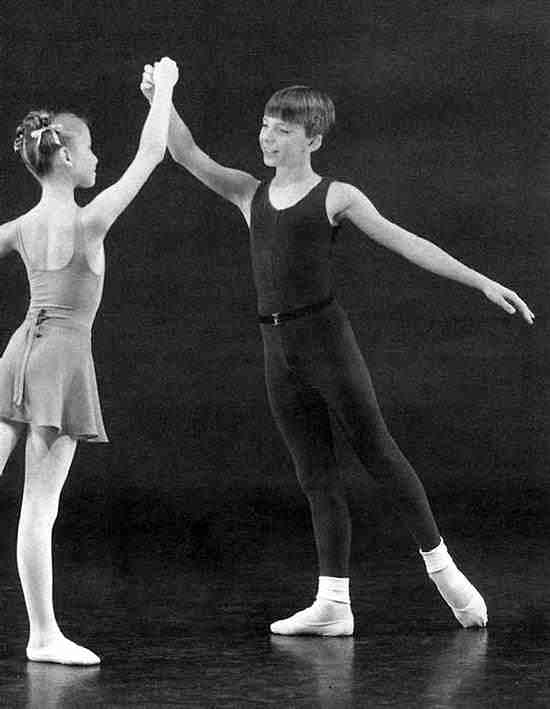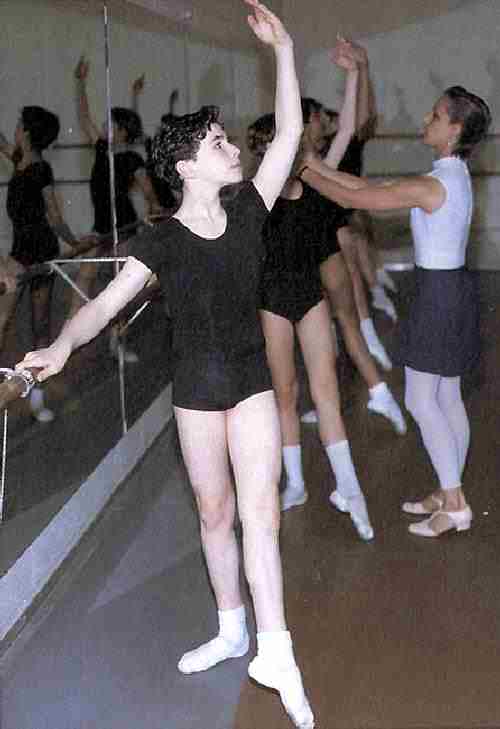
Figure 1.--These Canadian children are posing in their practice costumes. HBC has as yet no information on Canadian ballet. The boy wears a unitard with a seemingly unecessary belt.


Figure 1.--These Canadian children are posing in their practice costumes. HBC has as yet no information on Canadian ballet. The boy wears a unitard with a seemingly unecessary belt. |
HBC has no information on ballet in Canada. One HBC contributor, however has submitted an image from a Canadian ballet school. The National Ballet of Canada is of course the performing company to which all Canadian ballet students aspire.
The most prestigious Canadian school is the National Ballet School (L'Ecole Nationale de Ballet).
The core program of the National Ballet School accommodates approximately 150 talented students training for careers in dance. It combines a professional ballet curriculum with academic classes from Grades 5 through 12, and represents the highest standard of professional ballet training available in Canada. Students range in age from 10 to 18, with admission by audition only. Roughly two-thirds live on-site in the School's residence and are recruited from across Canada and abroad.
The training syllabus, unique to NBS, integrates elements from the best in progressive and acclaimed classical ballet training methods, as well as modern dance and the latest
advances in the science of movement. Studies, in addition to the daily ballet class,
include variations, repertoire, pas de deux, contact improvisation, character, flamenco, and historical dance. The program is further enhanced through the use of guest teachers from other renowned institutions.
Over the years, the School has developed a specialized and comprehensive body
conditioning program for all students. The program is designed to enhance ballet training through complementary conditioning that includes all aspects of physical fitness with particular emphasis on improving aerobic capacity. It features regular gym and pool training, fitness evaluations, basic education in anatomy, applied anatomy, exercise physiology, and nutrition. Gym facilities include a sprung floor, weights, small exercise equipment, and bicycles. The pool is also equipped with exercise equipment.
The School's commitment to developing the whole person is reflected in its strong
academic program. Academic studies support not only an immediate interest in a career in
dance but also the necessity to prepare for other career possibilities, including a career
after dance. Thus students have the benefit of both a strong academic foundation and
professional vocational training.
The School year extends from September to June, with mandatory attendance for 4 weeks at summer school in July for Grades 6 and up. Students in the Professional Ballet/Academic Program wear a school uniform which parents are responsible to provide. Similarly, a dress code exists for dance classes, with dancewear available at a discount through the School's on-site store. Each full-time female student in Grades 8 to 12 and male student in Grades 9 to 12 is required to own a theatrical make-up kit which is available from the School at a one-time cost of $100 (females) or $65 (males). In addition, the School has a well-developed
cultural enrichment program (including attendance at ballet and theatre performances).
Various options are available for the payment of fees. Fees do not include school uniforms, accident insurance, dance exams, and physiotherapy supplies (if needed). All resident students are required at the beginning of the year to deposit with the Head of Residence an adequate amount to cover out-of-pocket expenses.
Students in the Professional Ballet/Academic Program take academic classes on-site. The
entry level to the academic program is Grade 5, and students graduate from Grade 12 with
an Ontario Secondary School Diploma. The School is inspected annually by the Ontario
Ministry of Education and Training and all courses of study follow Ministry guidelines. In
addition to eight academic classrooms, the School has a science laboratory, film
laboratory, audio-visual room, library, music room, art room, computer room, and resource
centre.
The National Ballet School has its own male and female residence facilities on Maitland
Street for approximately 100 students in the Professional
Ballet/Academic Program. Included are kitchen and dining
facilities where NBS staff prepare all meals. House parents
work one to each residence floor overnight and alternate
week-end shifts. In addition to having adult counselors,
the younger students are each assigned a big brother or
big sister from the older student population. Special
outings are arranged throughout the year. Depending on
individual schedules and given the permission of parents
and the appropriate staff, students may go home for weekends.
Summer School is a 4-week dance training program offered every July. It serves as a second-stage assessment period for auditioning students and is mandatory for all returning students (except those finishing Grade 5) in both the Professional Ballet/Academic
and Intensive Dance Programs. Auditioning students are assessed by identifying those with not only appropriate physical attributes (e.g., mobility and flexibility in joints and muscles, the facility to work in a turned-out position) but also a combination of coordination, musicality, and dance ability. Academic test results and interpersonal skills are also taken into account. Only students who the School feels are able to respond positively to the program's broader challenges are invited to join the full-time Professional Ballet/Academic Program in September. Accommodation and meals are available during Summer School for Professional Ballet/Academic Program students (auditioning or returning).
The National Ballet School is committed to the development of the whole person, and has
been a pioneer in using health professionals to support its mission to develop healthy
dancers. For general physical care, a family practitioner is on call to the School and is
consulted as needed. A team of consulting psychiatrists/psychologists meet with students
in a class setting on a regular basis and make themselves available to individual students
on request. Students are given practical lessons on nutrition and stress management, and special priority is given to developing strategies to avoid eating disorders. Both a nutritionist and eating disorder specialist provide services as needed.

Figure 2.--This dancer wears a leotard with short pants and ankle socks. |
Dancers at the National Ballet School wear a varierty of costumes. One is a unitard, with ankle socks and ballet slippers (figure 1). The unitard has stirrups around the feet. He wears a belt
with it, although why he does is not known, as the garment is a one piece. Another is a black leotard with short black shorts, and ballet slippers with ankle socks (figure 2).
The NBS offers after-school and Saturday dance classes for boys and girls aged 6 to 12. The classes feature acclaimed teachers specializing in early dance training,
these classes combine personalized attention, a carefully constructed syllabus ­ and fun! Children take one, two or three classes a week depending on age
and level of training from mid-September to early June. Body
conditioning and pointe classes are also offered on a supplementary
basis where appropriate. There is a possibility of performance
opportunities, both in the Program's closing demonstration and in the
National Ballet of Canada's The Nutcracker. No previous ballet training is required. Children are accepted into the Junior Associates Program by audition to ascertain interest and suitability. Emphasis in the first years is on musicality and pleasure in movement, with the development of technique and artistry evolving
through six certificate levels. Each year the Associates receive two
formal reports on their progress. J.A. students are assessed each
spring by NBS faculty to ensure continuing interest and suitability for
dance training. J.A. students in academic Grades 4 and higher are
eligible to audition for Grades 5 through 12 at NBS; however,
participation in the Junior Associates Program is not intended as a
preparation for the School's full-time Professional Ballet/Academic
Program. Students are responsible for their own dancewear (available for purchase at the School's on-site retail store, The Shoe Room) and their own body conditioning attire.
Navigate the Historic Boys' Clothing Web Site:
[Introduction]
[Activities]
[Bibliographies]
[Biographies]
[Chronologies]
[Contributions]
[Countries]
[Frequently Asked Questions]
[Style Index]
[Boys' Clothing Home]
Navigate the Historic Boys' Clothing Web chronological pages:
[The 1890s]
[The 1900s]
[The 1910s]
[The 1920s]
[The 1930s]
[The 1940s]
[The 1950s]
[The 1960s]
[The 1970s]
Navigate the Historic Boys' Clothing Web dance pages:
[Return to the Main national ballet page]
[Return to the Main ballet page]
[Main Russian dance page]
[Irish step]
[Kilts]
[Highland]
[Ballroom]
[Native American]
[Tap]
